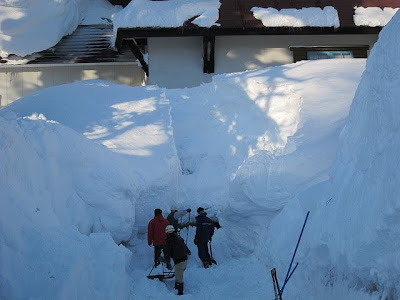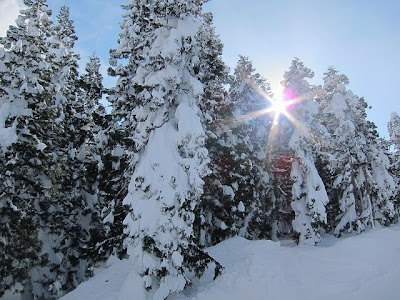
I used to think I knew what epic snow was. I was wrong. It turns out I didn't know what epic snow was until I set foot in the Japanese Alps.
We had left Kyoto at 11 p.m., riding the overnight bus northwest to Niigata prefecture. The lights were off, the curtains were closed, and the world outside the window was black. So when the bus arrived in the mountain town of Myoko seven hours later, none of us were prepared for what we were about to see.
The streets were lined with walls of snow two stories high. The rooftops were buried under snow three metres deep. The sky was dumping snow. Big, white flakes just pounding down from above. It piled up on our heads like scoops of ice cream while we were waiting for the driver to pull our luggage from the bowels of the bus. It was as if we had been magically transported to another world -- a world with so much snow it was almost suffocating.
I was travelling with a group of friends from all over the world, some of whom had never seen snow before moving to Japan. To them, this amount of snow was normal. It was what they saw in movies and, therefore, what they expected winter in a northern country would be like. But, for me, it was unbelievable. I had seen snow before but I had never seen snow like this before.





Interesting fact: Myoko averages 13 metres of snow each year. In comparison, Whistler receives an average annual snowfall of about 10 metres, while Banff receives about nine metres. Canada's snowiest cities (places like Montreal, St. John's, and Sudbury) top out at about two metres of snow each year. The reason for all of the snow along the western coast of Japan is due to the weather systems from Siberia that travel south across the Sea of Japan and pick up moisture as they go. Once over Japan, these weather systems meet the warm systems moving northward from the equator and the result is epic snow, unmatched anywhere else in the world. Between January and March, it almost never stops snowing. The deep powder makes Japan a paradise for skiers.


The ski resorts are western style but the apres ski scene is uniquely Japanese. A full day of skiing is followed by a long, hot soak in a rotenburo (open-air hot springs). I don't know what I like better: skiing through soft powder by day or sitting in a rotenburo in the midst of falling snow and rising steam by night. After bathing, you don't go out to a bar or a restaurant, you don slippers and a robe and head to a communal dining hall inside the hotel. By 7:30 p.m., everyone is back in their rooms for some chilled sake, or, in our case, cold umeshu (who needs ice when you can reach out the window and fill your cup with snow?). The day ends with the bliss of slipping into a fluffy futon on a tatami floor.



Travelling in Japan is unlike travelling anywhere else in the world. The country's top-notch customer service makes everything so easy, so efficient, so organized, it's like floating from one cloud to another. There was a dreamlike quality to our trip. The bus left on time and arrived on time. The lifts took us up the ski hill and gravity took us back down. We floated in the rotenburo and were swaddled and fed like babies afterward. There was nothing to think about and nothing to do except ski, eat, and sleep. The only intrusion into our bubble world was the snowplows that roared and beeped until midnight and started up again at 5 a.m.

We spent four days in Myoko, a tiny little ski town in the middle of Joshinetsu National Park. The town is nestled at the base of Mt. Myoko (2,454 metres) and Mt. Hiuchi (2,462 metres). There's not much on offer in-bounds for expert skiers but the resort is far away from the big crowds and the long lineups in Nagano and even further away from Niseko, which, according to everyone who has ever been there, is overrun by rude and obnoxious Australians. The longest lift queue in Myoko was about five minutes. Most of the time there was no queue at all. Going to Myoko meant sacrificing steepness for solitude. But it was a fair trade, especially for our group of newbie skiers from Brazil, Peru, Malaysia, Indonesia, and the Philippines.
I learned to ski in the ugly, industrial wasteland of Etobicoke, on a hill built on top of a giant garbage dump surrounded by Soviet-style apartment blocks. My dad took me there one snowy afternoon when I was about 10. He strapped a pair of skis on my feet, took me to the top of the hill, and gave me a push. Perhaps it's fitting that I learned to ski on a landfill because I still ski like garbage. My "technique" (if you can call it that) is to get down the mountain in one piece. Skiing is fun but, for me, the real joy comes from the beauty of the snow, the trees, and the mountains.


There's a misconception that skiing in Japan is expensive. If you don't mind sacrificing a few comforts, skiing in Japan can be extremely cheap. We each paid about $200 for our four-day trip, which included round-trip bus fare from Kyoto, lift tickets and equipment rentals for three days, two nights in a hotel, two dinners, and two breakfasts. Had we taken the bullet train instead of the overnight bus or asked for separate rooms instead of sharing one big room, the price would have been higher but it still would have been cheaper than skiing in Canada. At Whistler, it costs $96 just for a one-day lift ticket. Add in rental fees, transportation and food, and a single day at Whistler (nevermind a four-day trip) becomes prohibitively expensive.
Plus, by skiing in Japan, we got the added bonus of travelling back in time to 1984. The hotel, the rental equipment, and even the phone in our room were all relics from 30 years ago. It was like a living museum of the bubble years.



The gang from Kyoto University's Graduate School of Environmental Studies. From left to right: Jason from Malaysia, Glenn from the Philippines, Liliya from Bulgaria, Dani from Brazil, Violeta from Romania, Melina from Brazil, and me, representing Canada (not pictured: Angelica from Peru and Amir from Indonesia). A great trip with good friends.

7 comments:
Great photos. The snow in Myoko continues to amaze me.
It's incredible, isn't it?! Can't wait to go back...
Affordable Hotels in Delhi- Are you
looking for Hotels in Delhi? Call cheap hotel in Delhi Today @+91-9810104774 for Hotels
in Delhi at affordable rates.
Freeride Lodge has just been newly refurbished and renovated. Having been dormant for the last 8 years, she is finally operating again as a fun and vibrant budget accommodation option in Niseko. Freeride Lodge has been re-designed specifically to give you the best snow holiday experience possible. Freeride Lodge is owned and operated by the same friendly team as the Hooting Owl Lodge. It goes without saying that you can expect the same amazing level of service, cheap accommodation Niseko, snow accommodation niseko Japan, bedget accommodation Niseko, ski accommodation Niseko, Niseko Hostel accommodation, Niseko backpackers hospitality and good times here at Freeride, just ask our past customers. You can check out some of our reviews on here. We owe so much of The Hooting Owl’s overwhelming success to our amazing customers and we are so excited to be able to bring you Freeride Lodge.
Here at this site really the fastidious material collection so that everybody can enjoy a lot. snow accommodation
I will really appreciate the writer's choice for choosing this excellent article appropriate to my matter.Here is deep description about the article matter which helped me more. mp3 downloader
Post a Comment